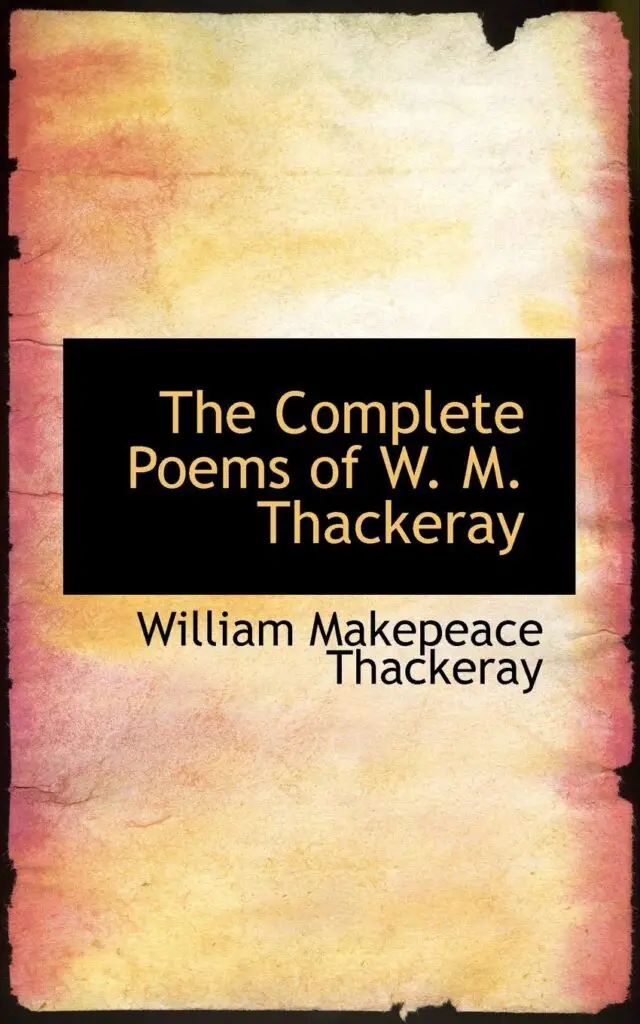William Makepeace Thackeray is one of the famous poets of the twentieth century who gives his best to English literature.
Thackeray has a variation that he put in his poem “The Cane Bottom’d Chair” which is an example of Thackeray’s bet verse. This is known as a long poem which is having many small stanzas.
Table of Contents
Summary
The poem begins with a scenery of having liquor. There is a pair of tattered slippers that have been almost toasted and the ragged jacket fills with the perfume of cigarette.
This is like a trap that the poet has made and he has snug like a kingdom upon the chair. To mount the realm poet makes toil and the atmosphere is like,
“But the fire there is bright and the air rather pure;”
Then the poet takes a reference to a chimney pot that is there in the way. In the next stanza, the poet talks about something else.
There is a snug chamber that is crammed with nooks and with old knick-knacks (knick knacks means a household object), and there also are books.

The foolish odd starts and also ends. Then the cracked bargains break and the cheap keepsake comes from friends.
In the next stanza, the poet further utters,
“Old armor, prints, pictures, pipes, china, (all crack’d,)
Old rickety tables, and chairs broken-backed;
A two penny treasury, wondrous to see;”
By this line, we can get to know all things get a crack even the old rickety table and the chairs receive a break in their back.
But it does not matter because the friends and the poet are enjoying the event. So, with the progress of the poem, Thackeray explains the table, chair, and even the sofa where a Sultan is not required.
Now the poet is saying that a song is coming from the sofa which is of its old age. Sounds are of the rickety, ramshackle body that seems very well.
There another sound also comes that the poet calls a ‘praying-rug’ perhaps from Turcoman’s camp. By the Tiber, the old lamp is twinkling and the slave’s dagger has been drawn to toast the muffins.
Here, these are the images that the poet has created maybe these are coming from his imaginative mind. In the next stanza, Thackeray explains that they are sitting and talking for a long time about books, and old friends, and that has become pleasure to all his friends and himself also.
“But of all the cheap treasures that garnish my nest,
There’s one that I love and I cherish the best:
For the finest of couches that are padded with hair
I never would change thee, my cane-bottom’d chair.”
This is how all the old treasures grains his nest and he loves them also cherishes them. Now he is uttering that whatever happens with the chair it does not matter and he would not change the ‘Cane-Bottom’d Chair ‘.
Now the poet starts describing his chair in detail. This is bend legged chair and high-shouldered where a person can eat. It has a worm-eating seat with a cracked back.

So, from his description, it can be said that the poet’s description is stating that the chair is very old and it may have broken. But still, it becomes very pleasurable and relaxing when the hips seat on that.
“I bless thee and love thee, old cane-bottom’d chair.”
By this line, the poet is expressing his love for the chair because he likes to spend time sitting on the chair. The poet is having such feelings for this cane-bottomed chair.
He looked, longed, and wished with his despair maybe to get it back. And at that time he also looked at the chair that gets damaged.
Now the poet is saying that as he loves the chair that is why he treats it like a temple of a saint and the throne of a prince.
Again the poet calls the poem ‘sweet patroness’ because it let the poet fanny a gentle sitting and it is the queen of the poet.
Now, the poet is enunciation about the night when the candle gets dimmed and the silence grows up there the poet sits by his fanny and he could see his fanny or hips are on the ‘cane bottom’d chair’.
At that time,
“She comes from the past and revisits my room;
She looks like as she then did, all beauty and bloom”
By these two lines perhaps the poet is talking about his beloved or of a lady who is dead. It seems that she comes from the past and revisits the room. Then she smiles and sits on the chair.
This is so fantastic because the chair is old and maybe this is how she used to sit on that in this way. Here the poem ends.
Theme
The poem is a mould with romanticism because the poet talks about the Cane Bottom’d Chair. He also imagines the chair that was there in the past and connects it with the present time.
The descriptions of the chairs seem like this is the love of the poet. So, romanticism and the cherished mind of the poem become the central theme of the poem.
Poetic Devices
A rhetorical device is a major part of the poem that makes a poet more attractive and significant. Thackeray follows a rhyme scheme that is ‘aaaa bb cc dd ee”. Except for this, we also have many literary devices like,
Syncope is a rhetorical device where the poet uses to write a word using apostrophe just like, ”tis’, ‘crack’d’, ‘Legg’d’, etc.
Then comes Anaphora which is the repetition of words at the beginning of two lines one after another.
“Old armor, prints, pictures, pipes, china, (all crack’d,)
Old rickety tables,”
Symbolism in The Cane Bottom’d Chair
Symbolism is another rhetorical device that takes place. Here, ‘little kingdom’ is a symbol of grand parentage.
Then comes Alliteration, which means the repetition of the same sounds in lines like “look’d and long’d”, “chamber is cramm’d”.
These are all the most important rhetorical devices of the poem that plays an important role.
